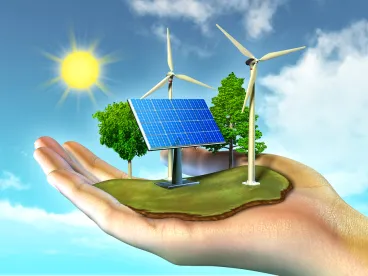In 2005, Congress passed the Energy Policy Act of 2005 (Pub. L. 109-58) (the EPAct), which (in relevant part) amended the Outer Continental Shelf Lands Act (43 U.S.C. §§ 1337 et seq.) to authorize the Department of Interior to issue regulations governing development of energy from offshore sources other than oil and gas. See EPAct, Sec. 388. “The Secretary of Interior delegated to the Bureau of Ocean Energy Management (BOEM) the authority to regulate activities under section 388(a) of the EPAct.” 30 C.F.R. § 585.100. In 2009, BOEM first issued regulations governing activities that “[p]roduce or support production, transportation, or transmission of energy from sources other than oil and gas[.]” 30 C.F.R. § 585.100(a).[1] BOEM implements its authority to issue offshore wind leases pursuant to these regulations in four phases,[2] each of which is discussed briefly below.
Planning and Analysis. During the planning and analysis phase, BOEM engages in consultations with interested parties, including state and federal government agencies, to identify offshore areas that are suitable for wind energy leasing. See BOEM Regulatory Framework Website. During this phase, BOEM also conducts preliminary environmental analyses, including analyses under the National Environmental Policy Act (NEPA).[3]
Leasing. The leasing phase of the process results in the issuance of wind leases. See BOEM Regulatory Framework Website. Although the EPAct authorizes lease issuance on either a competitive or noncompetitive basis, the regulations prioritize a competitive leasing process. See 30 C.F.R. § 585.201 (“BOEM will issue leases on a competitive basis .… However, if [BOEM] determine[s] after public notice of a proposed lease that there is no competitive interest, [it] will issue leases noncompetitively[.]”). BOEM uses “auctions to award leases on a competitive basis.”[4] 30 C.F.R. § 585.211. Competitive lease sales involve a series of steps, including calls for information and nominations,[5] identification of the lease area (through additional environmental analyses), publication of a proposed sale notice, and publication of a final sale notice. Id.[6] Potential lessees “may submit an unsolicited request for a … lease” in the absence of a competitive lease sale. 30 C.F.R. § 585.230. Upon receipt of an unsolicited request, BOEM will “issue a public notice of a request for interest” to determine whether there is a competitive interest in the proposal. 30 C.F.R. § 585.231(b). If there is competitive interest, then BOEM will initiate the competitive bidding process; if there is no competitive interest, then BOEM will consider the request and “may offer [] a noncompetitive lease.” 30 C.F.R. § 585.231(d)-(f). Lease issuance does not immediately authorize the lessee to construct facilities; instead, once a lease is issued, the lessee may conduct site assessment studies, develop a plan to construct wind energy facilities, and seek BOEM’s approval for development of the lease area. See BOEM 2020-025, Vineyard Wind 1 Offshore Wind Energy Project, Supplement to the Draft Environmental Impact Statement [hereinafter Vineyard Supplemental Draft EIS], p. A-3 (June 2020) (explaining that “commercial wind energy lease[s] [] give[] the lessee the exclusive right to seek BOEM approval for the development of the lease area.”).[7]
Site Assessment. After lease issuance, the lessee of a commercial lease has one year (the “preliminary term”) to prepare and submit a Site Assessment Plan (SAP), 30 C.F.R. § 585.235(a)(1), which sets forth the lessee’s proposal to construct a meteorological tower or buoys on the leased area. If BOEM timely receives an SAP that satisfies the regulatory requirements, then the preliminary term is extended for the period of time “necessary for [BOEM] to conduct technical and environmental reviews[.]” Id. If BOEM approves the SAP, then the lessee may undertake site assessment activities on the leased area, including installation of the meteorological tower or buoys, as well as additional site characterization analyses (e.g., animal, archeological).[8] Generally, lessees have up to five years after approval of an SAP to undertake the approved site assessment activities and to submit a Construction and Operations Plan (COP). 30 C.F.R. § 585.235(a)(2) (“A commercial lease will have a site assessment term of five years to conduct site assessment activities and to submit a COP[.]”).[9] The COP contains the lessee’s detailed plans for constructing and operating a wind energy project on the leased area. If BOEM timely receives a COP that satisfies the regulatory requirements, then the five-year site assessment term “will be automatically extended for the period of time necessary for [BOEM] to conduct technical and environmental reviews of the COP[.]” Id. “COP submittal triggers a project-specific NEPA analysis” (including an Environmental Impact Statement or an Environmental Assessment), after which “BOEM may approve, approve with modifications, or disapprove a lessee’s COP.” Vineyard Supplemental Draft EIS, p. A-3. (The time frames for submission of an SAP and COP may be extended.)
Construction and Operations. If BOEM approves the COP, then the lessee of a commercial lease “will have an operations term of 25 years [beginning on the day after BOEM approves the COP], unless a longer term is negotiated[.]” 30 C.F.R. § 585.235(a)(3). During the operations term, the lessee may “construct and operate wind turbine generators and associated facilities[.]” Vineyard Supplemental Draft EIS, p. A-3. The operations term may be extended through a lease renewal or a suspension of the operations term. 30 C.F.R. § 585.235(a)(4).
Vineyard Wind Lease.
A brief review of the history and current status of the Vineyard Wind LLC (Vineyard Wind) lease is illustrative of the process summarized above. Through the competitive leasing process, BOEM issued a commercial lease to Vineyard Wind in March 2015; the lease is designated as Lease OCS-A 0501. Vineyard Supplemental Draft EIS , p. ES-1. Under the lease, Vineyard Wind intends to construct, operate, and eventually decommission an 800-megawatt wind energy facility offshore Massachusetts. Id. See also 85 Fed. Reg. 35952, 35953 (June 12, 2020).
Vineyard Wind initially submitted its SAP to BOEM in March 2017 but subsequently revised that submission on multiple occasions; BOEM has since approved the SAP.[10] Vineyard Wind submitted its COP to BOEM in December 2017.[11] BOEM published a Draft Environmental Impact Statement (DEIS) relating to Vineyard Wind’s COP in December 2018, and subsequently held public meetings and solicited public comments on the DEIS.[12] The DEIS analyzed potential impacts of the proposed project and various alternatives to the proposal on wildlife, air and water quality, socioeconomic conditions, etc. Vineyard Wind submitted an updated COP in January 2020 and again in March 2020. See BOEM, Vineyard Wind, https://www.boem.gov/vineyard-wind. On June 12, 2020, BOEM published a Supplemental Draft Environmental Impact Statement, which “analyzes reasonably foreseeable effects from an expanded cumulative activities scenario for offshore wind development, previously unavailable fishing data, a new transit lane alternative, and changes since publication of the [DEIS]” to Vineyard Wind’s proposed project. Vineyard Supplemental Draft EIS, p. ES-1. Public meetings regarding the Supplemental Draft Environmental Impact Statement were held in June and July 2020, and the period to submit comments on the Supplemental Draft Environmental Impact Statement closed on July 27, 2020. BOEM contemplates publishing a final Environmental Impact Statement in November 2020 and publishing a Record of Decision in response to the COP in December 2020. See BOEM Supplemental Draft EIS Presentation, slide 29. The Record of Decision will announce whether BOEM approves Vineyard Energy’s COP.
Conclusion.
In sum, development of an offshore wind project under BOEM’s regulatory framework is a multiyear, multistep process involving rigorous planning, environmental analyses, and coordination among professionals across many fields of expertise, including (for example) environmental professionals who provide input on substantive analyses conducted under NEPA and other statutes, engineers involved in planning for the building and operation of wind energy facilities, business professionals who analyze the financial aspects and risks of wind energy projects, and legal professionals who provide advice on navigating each stage of BOEM’s leasing process (and on a variety of regulatory compliance issues during the life of a lease). Vineyard Wind’s experience will likely serve as an important example for years to come regarding how to maneuver through BOEM’s complex process for commercial wind energy leasing.
Footnotes
[1] BOEM’s regulations were updated in 2011 and 2014. See 76 Fed. Reg. 64432 (Oct. 18, 2011) (regulations updated to reflect reorganization of Interior Department sub-agencies); 79 Fed. Reg. 21617 (April 17, 2014) (regulations updated to extend time within which lessees must submit certain plans for BOEM approval, among other changes).
[2] See BOEM, Regulatory Framework and Guidelines, https://www.boem.gov/renewable-energy/regulatory-framework-and-guidelines [hereinafter BOEM Regulatory Framework Website].
[3] Under NEPA, federal agencies must conduct an environmental impact analysis before undertaking a “major federal action significantly affecting the quality of the human environment[.]” 42 U.S.C. § 4332(C). NEPA is a procedural statute, which requires agencies to conduct environmental analyses but does not dictate agency decision-making.
[4] “To date, BOEM has auctioned off 16 leases — most under a competitive auction process[.]” 20 Pratt’s Energy Law Report § 8.04 (September 2020).
[5] At this step, potential lessees submit information, including the location of interest for a potential lease, a description of the potential lessee’s objective, a general schedule of proposed activities, data regarding wind energy availability and environmental conditions in the target area, documentation supporting qualification, etc. 30 C.F.R. § 585.213. BOEM uses the information collected through this step of the process to identify the lease area, develop an approach for conducting environmental analyses and establishing leasing provisions, and prepare various environmental analyses (e.g., NEPA, CZMA, ESA, MMPA). 30 C.F.R. § 585.214.
[6] Under the regulations, BOEM may issue either a “commercial lease” or a “limited lease.” A commercial lease “specifies the terms and conditions under which a person can conduct commercial activities,” including (inter alia) “all activities associated with the generation, storage, or transmission of electricity or other energy product from a renewable energy project on the OCS [Outer Continental Shelf], and for which such electricity or other energy product is intended for distribution, sale, or other commercial use[.]” 30 C.F.R. § 585.112. A limited lease, on the other hand, “specifies the terms and conditions under which a person may conduct activities on the OCS that support the production of energy, but do not result in the production of electricity or other energy product for sale, distribution, or other commercial use exceeding a limit specified in the lease.” Id. The discussion above focuses on commercial leases.
[7] The Vineyard Supplemental Draft EIS is available at https://www.boem.gov/sites/default/files/documents/renewable-energy/Vineyard-Wind-1-Supplement-to-EIS.pdf.
[8] “BOEM assumes that every lessee will plan to install one meteorological tower or one to two meteorological buoys for site assessment.” Vineyard Supplemental Draft EIS, p. A-3.
[9] Lessees may submit the COP contemporaneously with the SAP. See 30 C.F.R. § 585.235.
[10] See BOEM, Vineyard Wind, https://www.boem.gov/vineyard-wind.
[11] See BOEM, Vineyard Wind Supplement to the Draft Environmental Impact Statement Public Meetings [the BOEM Supplemental Draft EIS Presentation], slide 11, available at https://www.boem.gov/sites/default/files/documents/renewable-energy/state-activities/VW-SEIS-Presentation.pdf.
[12] See BOEM 2018-060, Vineyard Wind Offshore Wind Energy Project, Draft Environmental Impact Statement, (December 2018), available at https://www.boem.gov/sites/default/files/renewable-energy-program/State-Activities/MA/Vineyard-Wind/Vineyard_Wind_Draft_EIS.pdf. See also BOEM, Vineyard Wind, https://www.boem.gov/vineyard-wind.




 />i
/>i

